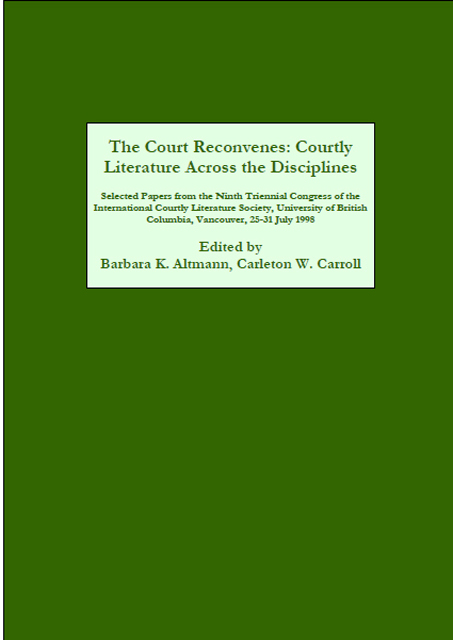 The Court Reconvenes
The Court Reconvenes Published online by Cambridge University Press: 31 March 2023
In the Grail romance, like in no other of Chrétien's romances, episodes are connected in often imperceptible subtlety. This is accomplished, however, within a clearly discernable narrative structure. Such a seeming paradoxon of mysteriousness and clarity is particularly evident in Perceval's internal wanderings from the mother to the hermit, which signify the psychological process of his growing out of childhood. Perceval's wandering out of the forest and through the stations of the narrative mirrors inner evolutionary stages. The central thread in these external and internal movements is the relationship of the son to the mother. The narrative action and the descriptive construction of Perceval's person revolve around the function of the mother. This is marked by several structural segments.
Indispensable in Perceval's progression is the forest, that of the mother and the forest of the hermit. The forest episodes motivate the relationship with the mother and design the hero's path in a circular pattern. Perceval comes from the forest and identifies with the forest, unlike Yvain and Tristan who flee the world for the forest. Supporting structural pillars are the sorrowful family history of the mother and her characterization as doel, and, finally, the linguistic epithets sot, fol, nice for Perceval: the gradual shifts in their meaning represent subtle changes in Perceval's internal progression.
Chrétien's Grail romance does not focus on a central female heroine as is customary. Among the faintly outlined female personages the mother's personality is presented in the palest contours and does not conform to modes of formal description. She dies early in the narrative, yet she is ever present in the phases her son must pass through. Her death provides the impetus for Perceval's wanderings, and her powerful absent presence decisively influences his inner growth.
The nucleus of the hero's personality is constructed around the description of the mother's family. Neither the geographical origin of the father nor the mother is specified. Both come from the vague “illes de mer” (419, 425). From the mother's story surfaces what is known of the father, that he was reputed for his prowess, was held in esteem by his vassals, was wounded, crippled and lost his lands (416ff.), a fate he has in common with numerous other vavasseurs in Chrétien's works. Of the mother we learn that she is of nebulous yet high aristocratic descent (423ff.).
To save this book to your Kindle, first ensure [email protected] is added to your Approved Personal Document E-mail List under your Personal Document Settings on the Manage Your Content and Devices page of your Amazon account. Then enter the ‘name’ part of your Kindle email address below. Find out more about saving to your Kindle.
Note you can select to save to either the @free.kindle.com or @kindle.com variations. ‘@free.kindle.com’ emails are free but can only be saved to your device when it is connected to wi-fi. ‘@kindle.com’ emails can be delivered even when you are not connected to wi-fi, but note that service fees apply.
Find out more about the Kindle Personal Document Service.
To save content items to your account, please confirm that you agree to abide by our usage policies. If this is the first time you use this feature, you will be asked to authorise Cambridge Core to connect with your account. Find out more about saving content to Dropbox.
To save content items to your account, please confirm that you agree to abide by our usage policies. If this is the first time you use this feature, you will be asked to authorise Cambridge Core to connect with your account. Find out more about saving content to Google Drive.